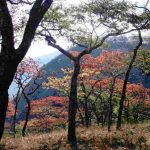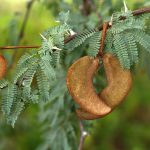TREE LIFE
December 1987
MASHONALAND CALENDAR
Sunday December 20th : No outing as such. Instead please join the committee at Phil and Cherlyl Haxen’s “The Shambles” Helensvale, Borrowdale for tea, mince pies, chin wags, etc., any time after 1000 hours. Come and enjoy our little woodland and see how some of Cheryl’s plantings are getting along. Tea will be on the go through most of the day. Bring your lunch pack, or if you prefer, a braai pack as we will have the braai going.
Friday December 25th : Christmas. Dick Hicks and his committee join in wishing you all a very Happy Christmas.
Tuesday January 5th : Botanic Garden walk. Meet in the car park at 1645 hours for 1700 hours.
MATABELELAND CALENDAR
Sunday December 6th : we will go to the Glenville Area, to the Blake’s house. Meet at 0830 hours opposite Northlea School, for Pilotage.
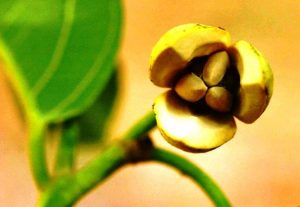
Annona stenophylla. Photo: Bart Wursten. Source: Flora of Zimbabwe
On Sunday November 1st we had a well attended meeting at the Old Gwanda Road and off the Circular Drive. Thora Hartley, our local guide, spoke very well on two species Pappea capensis and an Annona, not only unknown to most of us, but also unnoticed, heretofore, in an area we have visited several times. She produced a fine model of the fruit too. It was probably Annona stenophylla being just a shrublet, when seen, though it could be a young Annona senegalensis. However, like most of the trees in the area it was in young leaf, so it is difficult to say. Charles Sykes also spoke on Dalbergia melanoxylon, African black wood, and some samples were seen. Later at tea in the Hartley’s most notable garden, Norma Hughes told of an interesting, if somewhat repellant Root Parasite of Acacia karroo – Hypnora assimilis. In all we identified some 40 varieties.
Apart from the Annona there were other uncertainties, among them a very small Euclea, probably Euclea crispa. We also saw several large Parinari curatellifolia, uncommon in these parts. Burkea africana and Lannea discolor were fruiting heavily. Some Ehretia rigida were flowering, leaves not yet sand papery. Grewia flavescens was just starting to flower as was Acacia rehmanniana. Several Combretum molle were most attractive in very young bronze and silver leaf.
Both Azanza garckeana and Dombeya rotundifolia were there, in unusually small leaf as was Berchemia zeyheri. In the case of Azanza the usual scar on the back of the midrib was not easily apparent. Strychnos cocculoides had several good sized fruit probably quite dry inside.
-C. Sykes
THE GREAT DYKE – SUNDAY 15TH NOVEMBER 1987
The Great Dyke is an important geographical feature of Zimbabwe. It runs for approximately 500 km from the Zambezi escarpment in the north near Muzarabani across the country to finish north east of West Nicholson. It is rarely more than 10 km wide and is usually much narrower and formed by an intrusion or upswelling of molten rock along a narrow crack. Geographically, the Dyke consists of two rock types, serpentine which contains considerable amounts of toxic metals such as nickel and chromium and pyroxenite which lacks these metals. The pyroxenite is usually found running along the top of the Dyke with bands of serpentine on both sides. The metals to be found in the serpentine has given rise to an important mining industry along the Dyke and are also responsible for the interesting vegetation which contains a number of endemic species.
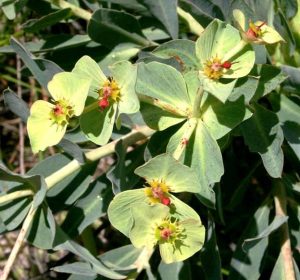
Euphorbia wildii. Photo: Bart Wursten. Source: Flora of Zimbabwe
The car park at Caesar mine provided a convenient starting point to explore the Dyke vegetation. A slightly delayed bus load of people arrived from Harare to join an assortment of others including friends from Centenary. After a refreshing cup of tea, kindly provided by the mining company, we climbed up the hillside above the car park to examine the plants to be found within the typical Dyke vegetation on the serpentine rock. Our attention was first captivated not by the trees but by two endemic species which give the Dyke its unique character, Euphorbia wildii, named after Professor Hiram Wild who first described much of the vegetation on the Dyke, and Aloe ortholopha with its characteristic branching pattern. Amongst the other herbaceous plants was the suffrutex, Elephantorrhiza elephantina, Euphorbia schinzii and the endemic Sutera species which still requires to be named. There are also a few trees which are endemic to the Dyke and we were pleased to find some small specimens of Ozoroa longipetiolata growing adjacent to the more widespread O. reticulata. Other trees characteristic of the Dyke were Diplorhynchus condylocarpon and Tapiphyllum velutinum. Some small Combretum molle, C. zeyheri, Heteromorpha trifoliate and Albizia antunesiana specimens illustrated how some species manage to grow in the toxic soil but remain stunted. A well formed violet tree, Securidaca longipedunculata, was in flower and gave a lovely scent. We also tried to smell the ethyl salicylate in the twigs of this tree which is partly responsible for the many medicinal properties that this tree is reputed to have.
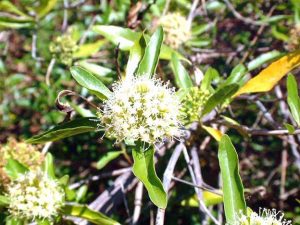
Nuxia oppositifolia .Photo: Rob Burett. Source: Flora of Zimbabwe
After being in the hot sun on the top of the Dyke we descended over Caesar pass, past some stands of Acacia karroo which is often found on the Dyke, and took our lunch within some shady riverine woodland amongst large specimens of Syzygium cordatum and Phoenix reclinata. A little way from the river grew Combretum zeyheri, the size of which contrasted to the stunted ones we had seen earlier in the day and were accompanied by Euclea divinorum, Brachystegia glaucescens, Maesa lanceolata, Maytenus undata, Myrica serrata, Apodytes dimidiata and Nuxia oppositifolia. The water running off the Dyke contains some of the toxic metals and snails are reputed not to be able to survive in the small streams. There is probably some effect on the vegetation but many species were found as we struggled along the river among which were Bequaertiodendron magalismontanum, Carissa edulis, Erythroxylum emarginatum, Ilex mitis, Olinia vanguerioides, Tarenna neurophylla and Vangueria apiculata. From the river we wandered through some drier woodland and found Olax obtusifolia, Ekebergia benguelensis and another species of Elephantorrhiza, E. goetzei.
After further refreshment we clambered back into the coach for the return trip to Harare travelling south along the western edge of the Dyke which gave a good view of the contrasting vegetation upon the bands of pyroxenite compared to the serpentine rock. Shortly after joining the Lomagundi road we ascended Great Dyke pass, which is on the pyroxenite, where we stopped for a short time to examine in more detail the vegetation. Brachystegia boehmii, Pseudolachnostylis maprouneifolia and Zanha africana were amongst the trees we had not seen earlier in addition to many more herbaceous species such as Vigna frutescens, Sphenostylis marginata and Tylosema fassogolensis.
R.M.
THE TEN TREE SECTION – 15TH NOVEMBER 1987
“If with me you’d fondly stray
Over the hills and far away”
This couplet aptly describes our ramble this day, if the word “hill” does not demean the majesty of the geological freak which is the Great Dyke.
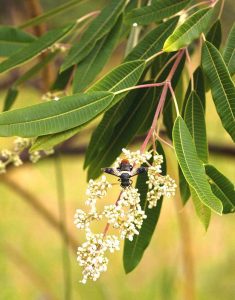
Ozoroa longipitiolata. Photo: Bart Wursten. Source: Flora of Zimbabwe
There were two rather special trees which we could not pass by – The Great Dyke Tarberry, Ozoroa longipetiolata, unique to this country and to the Great Dyke itself was duly compared with its more common relative Ozoroa insignis. Phoenix reclinata’s gutter shaped leaflets and spines at the base of the rachis were noted, but there were no wild dates to be had from it.
We paused to have a close look at Dombeya rotundifolia, the wild pear, but could spot only a few of the persistent brown petals which remain on the tree to protect the fruit until this is mature. We found both Cassia singueana, winter Cassia, and Cassia abbreviata, long tail Cassia, growing side by side next to Elephantorrhiza goetzei, Elephant root. Diplorhynchus condylocarpon, wild rubber tree, and Lannea discolor, live long tree, completed our view from the rock on which we sat – five for the price of one.
Syzygium quineense, waterberry with its fruit starting to turn purple but out of reach, and Bequaetiodendron magalismontanum, stem fruit, completed our visit to the riverine fringe.
What a truly lovely day
Over the hills and far away” NOT John Gay.
D.H.
KAROI – SEPTEMBER – OCTOBER 1987
Every month we get the much looked forward to Newsletter. How I long to go on the walks and outings. However, I decided to make my own Ten-tree Club. What with having a vast unexplored well wooded farm area, it seemed quite exciting and wonderful.
Before I started my walk I decided to decorate my Gudza hat with “Tassels for the Chief’s Hat” Dichrostachys cinerea, standing within the safety fence. By itself alone this “Mupangara” has amazingly beautiful contorted branches, any of which would make a Japanese arrangement blush. One cannot believe them to be one and the same tree when they become an impenetrable thicket due to overgrazing or poor soil.
I went along the fence and found that as expected more small bits of bark had been removed off the “muremberemba”- Cassia abbreviata, the long pod. There must have been a new rash of ‘stomach aches’ around for it to have so many new scars on its trunk. I don’t’ begrudge them this ‘muti’. There it stands traced in gold and new green against the blue sky – none the less beautiful.
Thinking of the hours of prickly heat ahead of me I pocketed one of the old hard woody halves of a pod – just the thing for a refreshing comb-out and scalp-scratcher, especially for short hair. I remembered also how I had used these self same old pods and bits of bark to make a magnificent dye a rich red brown for dying wool for our floor mats.
The Ziziphus mucronata said “wag-’n-bietje”, wait a bit, with its paired hooks one straight and the other hooked but being virtually leafless I did not stay long. I picked one of its rich tan-red berries to suck and again noted its conspicuous three veins from the base of the leaf which is such a useful feature to distinguish it from other tree leaves. As evening approaches this otherwise raggedy tree also standing in an open spot, had a beautiful silvery sheen all along its branches and tips where the young silvery haired new leaves were appearing. It is also called Buffalo Thorn and Muchechemi.
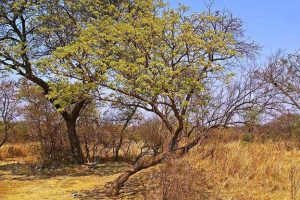
Albizia amara subsp. aericocephala. Photo: Meg Coates Palgrave. Source: Flora of Zimbabwewe
Soap has become a dreadful problem and I decided to make my next stop under the semi-shade of the magnificent Muora trees which stand as sentinels, ancient and tall, like the tallest Acacia. But they were just starting in leaf, fine Acacia like leaflets although its flower heads, the beautiful creamy off white, half pom poms, had not yet opened. This tree, the Albizia amara subsp. aericocephala, is one of the most handsome trees in our vicinity. They have become so ancient because they stand on our farm which makes up part of “muora”. If you ask – “where are the cattle?” “lapa Muoras” is the answer or where did the old people live, the answer is the same. I did not succeed in getting a bit of root which contains soap in it and can be used as a substitute for soap. Having found only one young Muora, Albizia amara, I did not like to hurt it. One old one was slowly becoming more horizontal, part of its roots sticking up out of the soil.
I was getting hungry and hot and stopped under a most beautiful tree covered in pink velvety leaf tips, the pink Diospyros, D. kirkii. They are so tactile, I simply had to see, and stand and stare. Higher up there were still some of the edible fruits, very large in size for such a sort of tortured little black barked tree. It had one hole right through its main trunk. I helped myself to a few which were still amazingly soft and edible, large and pale biscuit. They had taken ages, right through the winter, to develop.
Just across from my pink Diospyros, my most beloved tree stood, the kudu berry, “Muzonzowa”, Pseudolachnostylis maprouneifolia and all. Why make a floral arrangement when one could wander a few steps in the veldt and have your fill of this perfectly proportioned tree, dressed in finely textured see through young lime green leaves, each of the delicate dropping branchlets going into a private ballet of their own. No drawing or photograph has yet done justice to this exquisite seemingly transparent tree. Now there were no yellow berries but how well I remembered slipping on them in March when they carpeted the red clay like soil of the tractor spoor I was following. The kudus had enough berries on their side of the fence at Good Hope The Muzonzowa’s famous autumnal colours, at the end of winter, had been disappointing this year. Was it because Faurea speciosa had taken my breath away with its tall rich red beauty against a shimmering evening sky?
Not having had much joy of shade in the early October heat I rushed to the cool green darkness of the shade of a Ficus sur, capensis. I was nearly there when I noticed two kuwa – a – a, Go way birds, cocking their crests at me as if disdaining my presence in their and their friends’ the Loeries’ feed lot – they zipped off to the next fat green blob of a Ficus. I collected some fruits pinky – red to cook for jam with leaves and a bit of aniseed to give it some taste. Cleaning in salt water helps to remove the many tiny wasps inside the “flowers”. Once upon a time beautiful bark cloth was made from the bark of a Ficus.
I had decided to make an outdoor mural quite long ago and after hearing of the wonderful qualities of the milky sap of the Euphorbia ingens, which had probably helped the Zan Bushmen as a fixative for their paints on the cave walls and other rocky outcrops. I collected some of this sticky stuff. I put this white liquid into three separate little tins and added red iron oxide to one, some yellow ochre to the other and a little bit of nickel oxide in powder form to the other. So far no water or heat or cold has affected the painting. Never touch our face or eyes while working. It is poisonous and would burn the eyes quite severely. The Euphorbia ingens usually grows near or on the granite rocky outcrops.
When I came to the many Erythrina abyssinica I thought of earning a bit of pocket money. Since 1984 Professor Dowdle of the Medical School at the UCT has made a call on anybody to help in obtaining seeds from this lucky bean tree. The bean contains a protein which helps to break down an enzyme which is used in the treatment of heart attacks. With the help of friendly people in Southern Africa one of the Prof’s pupils have worked on her Doctorate in England and the lucky bean is now being processed for this new muti which many chemical houses now want to distribute. Only one stunted small tree was throwing out its little black and red seeds during this early October walk and I would have to collect more later on.
At last I was returning home via a vlei where I had spotted the Strychnos cocculoides the Mutamba or Monkey Orange with its tough woody outer skin. I collected as many as I could from the tree. They were still rather pale yellow. They would be ideal for the game of bowls the children were planning to play on the lawn that evening. Some riper broken shells had had their marvelous flavoured pulp eaten.
And so ended a short days delight, so much more to see!
-Some Esterhuizen
Thank you. It sound delightful. One day we would love to come and share your tree ecstasy,
-JPHaxen


